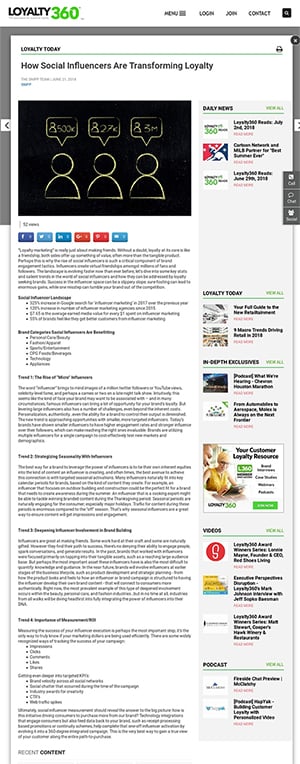 “Loyalty marketing” is really just about making friends. Without a doubt, loyalty at its core is like a friendship; both sides offer up something of value, often more than the tangible product. Perhaps this is why the rise of social influencers is such a critical component of brand engagement tactics. Influencers create virtual friendships amongst millions of fans and followers. The landscape is evolving faster now than ever before; let’s dive into some key stats and salient trends in the world of social influencers and how they can be addressed by loyalty seeking brands. Success in the influencer space can be a slippery slope; sure-footing can lead to enormous gains, while one misstep can tumble your brand out of the competition.
“Loyalty marketing” is really just about making friends. Without a doubt, loyalty at its core is like a friendship; both sides offer up something of value, often more than the tangible product. Perhaps this is why the rise of social influencers is such a critical component of brand engagement tactics. Influencers create virtual friendships amongst millions of fans and followers. The landscape is evolving faster now than ever before; let’s dive into some key stats and salient trends in the world of social influencers and how they can be addressed by loyalty seeking brands. Success in the influencer space can be a slippery slope; sure-footing can lead to enormous gains, while one misstep can tumble your brand out of the competition.
Social Influencer Landscape
- 325% increase in Google search for ‘influencer marketing’ in 2017 over the previous year
- 120% increase in number of influencer marketing agencies since 2015
- $7.65 is the average earned media value for every $1 spent on influencer marketing
- 55% of brands feel like they get better customers from influencer marketing
Brand Categories Social Influencers Are Benefitting
- Personal Care/Beauty
- Fashion/Apparel
- Sports/Entertainment
- CPG Foods/Beverages
- Technology
- Appliances
Trend 1: The Rise of “Micro” Influencers
The word “influencer” brings to mind images of a million twitter followers or YouTube views, celebrity-level fame, and perhaps a cameo or two on a late-night talk show. Intuitively, this seems like the kind of face your brand may want to be associated with – and in many circumstances, famous influencers can bring a lot of opportunity for your brand’s loyalty. But levering large influencers also has a number of challenges, even beyond the inherent costs. Personalization, authenticity…even the ability for a brand to control their output is diminished. The new trend is approaching opportunities with smaller, more targeted influencers. Today’s brands have shown smaller influencers to have higher engagement rates and stronger influence over their followers, which can make reaching the right ones invaluable. Brands are utilizing multiple influencers for a single campaign to cost-effectively test new markets and demographics.
Trend 2: Strategizing Seasonality With Influencers
The best way for a brand to leverage the power of influencers is to tie their own inherent equities into the kind of content an influencer is creating, and often times, the best avenue to achieve this connection is with targeted seasonal activations. Many influencers naturally fit into key calendar periods for brands, based on the kind of content they create. For example, an influencer that focuses on outdoor building and construction could be the perfect fit for a brand that needs to create awareness during the summer. An influencer that is a cooking expert might be able to tackle winning branded content during the Thanksgiving period. Seasonal periods are naturally engaging for the consumer; especially major holidays. Traffic for content during these periods is enormous compared to the “off” season. That’s why seasonal influencers are a great way to ensure content will get impressions and engagement.
Trend 3: Deepening Influencer Involvement in Brand Building
Influencers are great at making friends. Some work hard at their craft and some are naturally gifted. However they find their path to success, there’s no denying their ability to engage people, spark conversations, and generate results. In the past, brands that worked with influencers were focused primarily on tapping into their tangible assets, such as a reaching large audience base. But perhaps the most important asset these influencers have is also the most difficult to quantify: knowledge and guidance. In the near future, brands will involve influencers at earlier stages of the business lifecycle, such as product development and strategic planning – from how the product looks and feels to how an influencer or brand campaign is structured to having the influencer develop their own brand content – that will connect to consumers more authentically. Right now, the most prevalent example of this type of deepened involvement occurs within the beauty, personal care, and fashion industries…but in no time at all, industries from all walks will be diving headfirst into fully integrating the power of influencers into their DNA.
Trend 4: Importance of Measurement/ROI
Measuring the success of your influencer execution is perhaps the most important step; it’s the only way to truly know if your marketing dollars are being used efficiently. There are some widely recognized ways of tracking the success of your campaign:
- Impressions
- Clicks
- Comments
- Likes
- Shares
Getting even deeper into targeted KPI’s:
- Brand velocity across all social networks
- Social chatter that occurred during the time of the campaign
- Industry awards for creativity
- CTR’s
- Web traffic spikes
Ultimately, social influencer measurement should reveal the answer to the big picture: how is this initiative driving consumers to purchase more from our brand? Technology integrations that engage consumers but also feed data back to your brand, such as receipt-processing based promotions or continuity schemes, help complete that one-off influencer activation by evolving it into a 360-degree integrated campaign. This is the very best way to gain a true view of your customer along the entire path-to-purchase.

